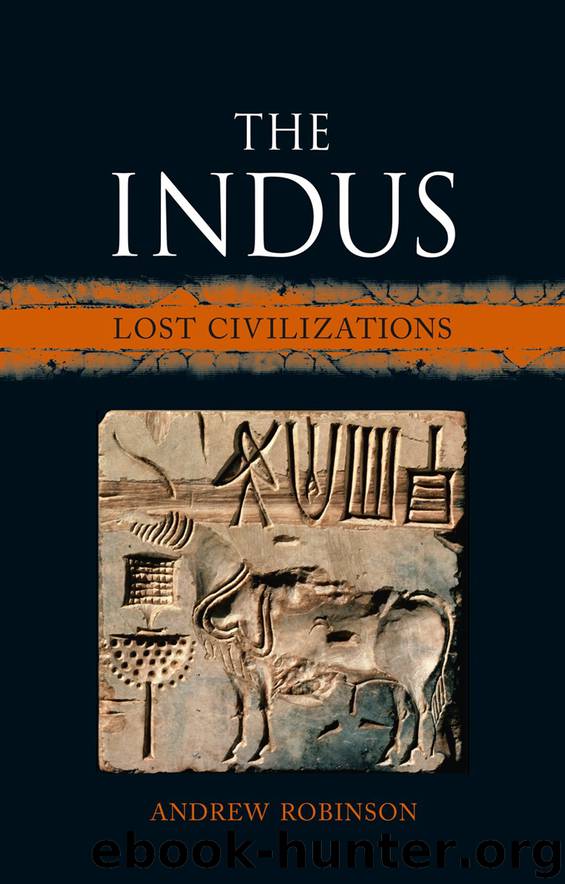The Indus by Andrew Robinson

Author:Andrew Robinson
Language: eng
Format: epub
Publisher: Reaktion Books
Impression of a cylinder seal from Kalibangan showing two men apparently fighting over a woman. Violent scenes are extremely uncommon in Indus art.
Further evidence for a central Indus authority comes from the anti-flood platforms underlying various Indus cities. Earlier we noted that the vast scale of organized effort required to build the platform at Mohenjo-daro must have been motivated by the destruction caused by the annual floods of the Indus. This is a reasonable assumption. To carry out the gigantic task, one presumes that the labour force, though voluntary, would have required mobilization, direction and provisioning by a central authority, in the absence of slavery, for which there is no evidence. The construction of the pyramids at Giza in ancient Egypt at around the same time as the foundation of Mohenjo-daro in the mid-third millennium BC would appear to be an apt comparison, since the former is thought to have been accomplished by a strong ruler but without the use of slave labour.
The existence of successful trading networks over a vast area in and around the Indus valley is also suggestive of a central authority. It is difficult to see how such networks could have developed and operated effectively for five or six centuries without an infrastructure of basic roads between settlements, presumably maintained by taxation, and also some kind of regulatory framework to enforce the validity of a commercial agreement made by a trader at, say, Lothal, when he was subsequently trading at distant Harappa or even more distant Shortugai. Both the maintenance of roads and the framing of regulations would have required an urban-based coordinating authority with responsibility for numerous settlements, not just one city. Indeed, a good case can be made that trade, and the specialized technologies on which much Indus trade depended, might have legitimized such a coordinating authority in the eyes of the average Indus dweller. For the cities, through their workshops, controlled the production from raw materials of objects such as shell and stoneware bangles, carnelian beads and gold jewellery, which were used to define social status and conduct rituals. Furthermore, the area-wide system of standardized weights lends credence to the idea of a central authority. These weights clearly worked well, because the system survived long after the disappearance of the Indus civilization.
Most telling of all in this context are the seals, since they are found in every part of the Indus area (as well as in the Persian Gulf and Mesopotamia). They must originally have been conceived by a central authority and backed by its prestige – rather like the ubiquitous coinage of modern nations, which is backed by the reputation of a central bank. But rather than acting as a currency, the Indus seals were almost certainly markers of identity. Exactly how this identity was defined by the seal motif and accompanying inscription is of course unknown. Leaving aside the inscriptions for later analysis, what may plausibly be said about the motifs? Kenoyer offers one interesting interpretation:
Square stamp seals with animal motifs carried messages understandable to all the different communities living in the Indus cities.
Download
This site does not store any files on its server. We only index and link to content provided by other sites. Please contact the content providers to delete copyright contents if any and email us, we'll remove relevant links or contents immediately.
| Anthropology | Archaeology |
| Philosophy | Politics & Government |
| Social Sciences | Sociology |
| Women's Studies |
Mysteries by Colin Wilson(3420)
People of the Earth: An Introduction to World Prehistory by Dr. Brian Fagan & Nadia Durrani(2710)
Ancient Worlds by Michael Scott(2646)
Foreign Devils on the Silk Road: The Search for the Lost Treasures of Central Asia by Peter Hopkirk(2441)
The Splendid and the Vile by Erik Larson(2406)
The Memory Code by Lynne Kelly(2371)
Come, Tell Me How You Live by Mallowan Agatha Christie(2225)
Lost Technologies of Ancient Egypt by Christopher Dunn(2206)
The Earth Chronicles Handbook by Zecharia Sitchin(2201)
The Plantagenets by Dan Jones(2058)
Last Chance to See by Douglas Adams(1956)
The Return of the Gods by Erich von Daniken(1912)
Wars of the Anunnaki by Chris H. Hardy(1691)
Keeper of Genesis by Graham Hancock(1621)
Before the Dawn by Nicholas Wade(1583)
The Cygnus Mystery by Andrew Collins(1535)
The Message of the Sphinx by Graham Hancock(1488)
Fragile Lives by Stephen Westaby(1437)
A History of the World in 100 Objects by MacGregor Neil(1331)
